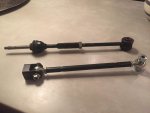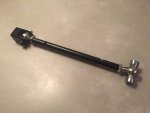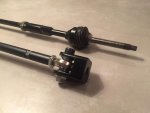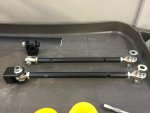Tie rods self made
- Thread starter Jason Watt
- Start date
You are using an out of date browser. It may not display this or other websites correctly.
You should upgrade or use an alternative browser.
You should upgrade or use an alternative browser.
- Apr 6, 2014
- 1,093
Great workmanship!! You gonna be able to send us some over here??
Sent from my iPhone using Tapatalk
Sent from my iPhone using Tapatalk
Thanks..
I'm sure it's easier and cheaper to have some made locally.
Perhaps someone US based on the forum could pick up on the idea and produce them for members??
I'm sure it's easier and cheaper to have some made locally.
Perhaps someone US based on the forum could pick up on the idea and produce them for members??
NorthwoodGT
GT Owner
Wow-the design is superb! I have always questioned the integrity of the OEM link. the bend always looked weak to me and I never liked the way the bushing end floated on the knuckle. plus it was basically designed from the 02/05 Thunderbird and Lincoln LS. although from what I've been told, they used the OEM part on the 2017 GT mule cars as well.
I have always questioned the integrity of the OEM link. the bend always looked weak to me and I never liked the way the bushing end floated on the knuckle. plus it was basically designed from the 02/05 Thunderbird and Lincoln LS. although from what I've been told, they used the OEM part on the 2017 GT mule cars as well.
The subject part is a direct 'lift' from the Lincoln LS and Jaguar which shared a platform at that time. It's a robust piece; curiously, do you have any data that would indicate to the contrary?
NorthwoodGT
GT Owner
I have no documentation or FE data on the part but I've seen quite a few that were folded up on wrecked cars. from a compression or tension standpoint the part works good. I just have to wonder how much stress analysis and bend were measured for such a critical control part for a supercar. for a Tbird and LS I'm sure it's more than adequate but then again if it's being used on the NGT, it must be OK. all jmo
The subject part is a direct 'lift' from the Lincoln LS and Jaguar which shared a platform at that time. It's a robust piece; curiously, do you have any data that would indicate to the contrary?
Well I for many has found these links to develop play in the inner ball section.
Might be OK for the average owner, but when TT'ing and taking the GT to the track, the old Lincoln unit s not strong enough.
NorthwoodGT
GT Owner
Ford Design Analysis
My thoughts as well. I am always amazed at others who know more about designing safety critical (the steering tierods serve a critical steering function) components on high performance cars than the Ford design engineers. Not that new tierods cannot be designed and made to carry higher steering loads, but is it necessary?:confused
The tierods designed and pictured by one of 101 look fantastic and likely can handle higher loads. The spherical bearings at each end are beautiful and provide inner and outer length adjustment thru threaded engagement in the tierod barrel. From an OE perspective under a very compressed design timeline (designed, developed and launched in 24 months), weight and cost targets it certainly makes perfect sense to borrow components from other product lines with a known history and structural adequacy. During my design career I was always reminded that Better is the enemy of Good Enough.
As to the structural adequacy issue, I am most certain that the Ford suspension designers instrumented critical suspension components to determine road and race track loads. Due to the high performance/speed nature of our GT’s and the risk adverse stance of corporate liability, I am again sure a large safety factor (load to fail the component/maximum operating load) was applied to the design to keep the lawyers happy.
Scott, I do not know where or how you would gain access to internal Ford documentation of the loads or Finite Element (FE) analysis the design team used to analyze the tie rod. As documented in SAE publication 2004-01-1255, “Design and Analysis of the Ford GT Spaceframe”, Ford used a number of analytical structural analysis programs (HyperMesh, NASTRAN and LS-DYNA) to design and insure component structural adequacy. Design loads were measured using test mule vehicles. Just because you see tierods which are “folded up on wrecked cars” implies nothing as to the component design for satisfying its intended function. Aircraft which crash into the ground due to pilot error can appear pretty “folded up” as well, but it means nothing about the aircraft structure while it is flying within its design envelope. Engineers typically do not design a component to function after design ultimate or crash loads have been applied.
Well, perhaps you should go read the SAE report 2004-01-1255 to answer your question on how much stress analysis and bend (?) was conducted on the FGT design. For that matter you and others with a technical interest should read the full 11 report suite of technical reports published under SAE PT-113. Very good technical documentation on our cars design.:thumbsup
The subject part is a direct 'lift' from the Lincoln LS and Jaguar which shared a platform at that time. It's a robust piece; curiously, do you have any data that would indicate to the contrary?
My thoughts as well. I am always amazed at others who know more about designing safety critical (the steering tierods serve a critical steering function) components on high performance cars than the Ford design engineers. Not that new tierods cannot be designed and made to carry higher steering loads, but is it necessary?:confused
The tierods designed and pictured by one of 101 look fantastic and likely can handle higher loads. The spherical bearings at each end are beautiful and provide inner and outer length adjustment thru threaded engagement in the tierod barrel. From an OE perspective under a very compressed design timeline (designed, developed and launched in 24 months), weight and cost targets it certainly makes perfect sense to borrow components from other product lines with a known history and structural adequacy. During my design career I was always reminded that Better is the enemy of Good Enough.
As to the structural adequacy issue, I am most certain that the Ford suspension designers instrumented critical suspension components to determine road and race track loads. Due to the high performance/speed nature of our GT’s and the risk adverse stance of corporate liability, I am again sure a large safety factor (load to fail the component/maximum operating load) was applied to the design to keep the lawyers happy.
I have no documentation or FE data on the part but I've seen quite a few that were folded up on wrecked cars. from a compression or tension standpoint the part works good.
Scott, I do not know where or how you would gain access to internal Ford documentation of the loads or Finite Element (FE) analysis the design team used to analyze the tie rod. As documented in SAE publication 2004-01-1255, “Design and Analysis of the Ford GT Spaceframe”, Ford used a number of analytical structural analysis programs (HyperMesh, NASTRAN and LS-DYNA) to design and insure component structural adequacy. Design loads were measured using test mule vehicles. Just because you see tierods which are “folded up on wrecked cars” implies nothing as to the component design for satisfying its intended function. Aircraft which crash into the ground due to pilot error can appear pretty “folded up” as well, but it means nothing about the aircraft structure while it is flying within its design envelope. Engineers typically do not design a component to function after design ultimate or crash loads have been applied.
I just have to wonder how much stress analysis and bend were measured for such a critical control part for a supercar. for a Tbird and LS I'm sure it's more than adequate but then again if it's being used on the NGT, it must be OK. all jmo
Well, perhaps you should go read the SAE report 2004-01-1255 to answer your question on how much stress analysis and bend (?) was conducted on the FGT design. For that matter you and others with a technical interest should read the full 11 report suite of technical reports published under SAE PT-113. Very good technical documentation on our cars design.:thumbsup
ThatPhilBrettGuy
GT Owner
I'd probably rather have a cheap(ish) rod bend and use up some crash energy, than it transferring it to a more expensive part.
That said, One of 101's are lovely
That said, One of 101's are lovely
cobra498
GT Owner
My thoughts as well. I am always amazed at others who know more about designing safety critical (the steering tierods serve a critical steering function) components on high performance cars than the Ford design engineers. Not that new tierods cannot be designed and made to carry higher steering loads, but is it necessary?:confused
The tierods designed and pictured by one of 101 look fantastic and likely can handle higher loads. The spherical bearings at each end are beautiful and provide inner and outer length adjustment thru threaded engagement in the tierod barrel. From an OE perspective under a very compressed design timeline (designed, developed and launched in 24 months), weight and cost targets it certainly makes perfect sense to borrow components from other product lines with a known history and structural adequacy. During my design career I was always reminded that Better is the enemy of Good Enough.
As to the structural adequacy issue, I am most certain that the Ford suspension designers instrumented critical suspension components to determine road and race track loads. Due to the high performance/speed nature of our GT’s and the risk adverse stance of corporate liability, I am again sure a large safety factor (load to fail the component/maximum operating load) was applied to the design to keep the lawyers happy.
Scott, I do not know where or how you would gain access to internal Ford documentation of the loads or Finite Element (FE) analysis the design team used to analyze the tie rod. As documented in SAE publication 2004-01-1255, “Design and Analysis of the Ford GT Spaceframe”, Ford used a number of analytical structural analysis programs (HyperMesh, NASTRAN and LS-DYNA) to design and insure component structural adequacy. Design loads were measured using test mule vehicles. Just because you see tierods which are “folded up on wrecked cars” implies nothing as to the component design for satisfying its intended function. Aircraft which crash into the ground due to pilot error can appear pretty “folded up” as well, but it means nothing about the aircraft structure while it is flying within its design envelope. Engineers typically do not design a component to function after design ultimate or crash loads have been applied.
Well, perhaps you should go read the SAE report 2004-01-1255 to answer your question on how much stress analysis and bend (?) was conducted on the FGT design. For that matter you and others with a technical interest should read the full 11 report suite of technical reports published under SAE PT-113. Very good technical documentation on our cars design.:thumbsup
Could not agree more, I changed my tie rod ends on my Cobra to a very similar set up from OEM mainly for convenience of bump steer adjustment. Now I am replacing very expensive NMB rod ends on a yearly basis because they get sloppy since they are teflon lined and the lining wears. The Ford GT OE parts are your best bet for anything but all out racing.
Thank you cobra498 for sharing with us your real-world application experience. There are always design tradeoffs to consider, and designs can always be improved. In your case you went to much more expensive NMB tierod ends for a very specific bump-steer issue. But your tradeoff was frequent replacement and associated costs to address this very specific issue. The Ford OE tierods (IMO) satisfy the design requirements for almost all our FGT owners’ needs.
PhilBrettGuy also brings into focus another important overall factor, that of energy absorption during a crash. Although I did not list this as a design consideration, it absolutely is. You want ANY vehicle structure to absorb crash induced load instead of passing it along to the human occupants. You want structures to bend as that takes energy which is consumed and lessens the load to the occupants.
PhilBrettGuy also brings into focus another important overall factor, that of energy absorption during a crash. Although I did not list this as a design consideration, it absolutely is. You want ANY vehicle structure to absorb crash induced load instead of passing it along to the human occupants. You want structures to bend as that takes energy which is consumed and lessens the load to the occupants.





